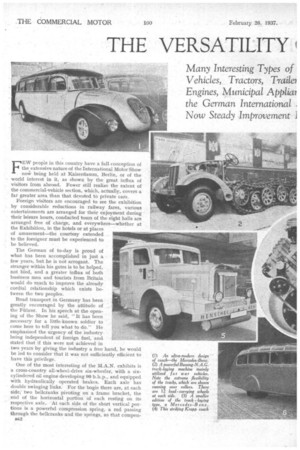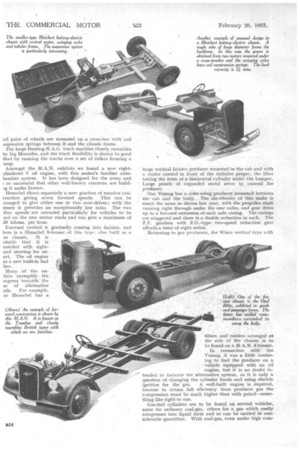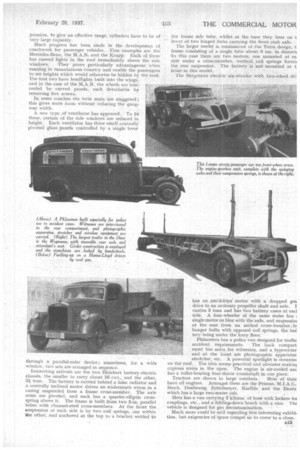THE VERSATILITY IF GERMAN DESIGN
Page 46

Page 47

Page 48

Page 49

If you've noticed an error in this article please click here to report it so we can fix it.
Many Interesting Types of Vehicles, Tractors, Trailer
Engines, Municipal Appliat the German International Now Steady Improvement
Is and Passenger Chassis and :attery-electrics, Oil and Gas
Ind War Machines Staged at
) in Berlin. The Keynote is
.?r Than Spectacular Changes FEW people in this country have a full conception of the extensive nature of the International Motor Show no being held at Kaiserdamm, Berlin, or of the world interest in it, as shown by the great influx of visitors from abroad. Fewer still realize the extent of the commercial-vehicle section, which, actually, covers a far greater area than that devoted to private cars.
Foreign visitors are encouraged to see the exhibition by considerable reductions in railway fares, various entertainments are arranged for their enjoyment during their leisure hours, conducted tours of the eight hails are arranged free of charge, and everywhere—whether at the Exhibition, in the hotels or at places of amusement—the courtesy extended to the foreigner must be experienced to be believed.
The German of to-day is proud of what has been accomplished in just a• few years, but he is not arrogant. The stranger within his gates is to be helped, not bled, and a greater influx of both business men and tourists from Britain would do much to improve the already cordial relationship which exists between the two peoples.
Road transport in Germany has been greatly encouraged by the attitude of
the Fiihrer. In his speech at the opening of the Show he said, "It has been necessary for a little-known soldier to come here to tell you what to do." He emphasized the urgency of the industry being independent of foreign fuel, and stated that if this were not achieved in two years by giving. the industry a free hand, he would be led to consider that it was not sufficiently efficient to have this privilege.
One of the most interesting of the M.A.N. exhibits is a cross-country all-wheel-drive six-wheeler, with a sixcylindered oil engine developing 90 b.h.p., and equipped with hydraulically operated brakes. Each axle has double swinging links. For the bogie there are, at each side, two belkranks pivoting on a frame bracket, the end of the horizontal portion of each resting on its respective axle. At each side of the short vertical portions is a powerful compression spring, a rod passing through the bellcranks and the springs, so that compen
u.i.2 sation is obtained. The final drive is by short earth shafts. The arrangement for the front axle is sirnila but only one belIcra:nk is employed at each side in col junction with a single coil spring. The drive for ti engine is taken through a gearbox and then to a doubh reduction box, from which it passes, at a lower level, t the overhead worms.
The Bussing-N.A.G. four-wheel-drive four-wheelers carry about 6 tons, has its driven axles practically dupl ca,ted, with torque tubes passing backwards and fol wards, respectively, to ball housings on cross tubet Here, again, the drive is dropped to a lower level from gearbox affording eight speeds, Ion propeller shafts being used.
The Opel concern shows a new Op( Blitz 3-tonner, also to be seen in pas senger form. The main feature of th design lies in the frame construction The side members are of channel stee with inverted-U cross-members welde, to them and extended to carry th body. This obviates trouble with th loosening of bolts or rivets when separ ate side extensions are employed. Th. brakes are of the Lockheed pattern.
Three chassis which attract consider able attention are the Mercedes-Ben. and Bussing-N.A.G. track-type vehicles the former showing a large and a smal model. The bigger has at each side tw( inverted semi-elliptic springs, each enc • of which has .a beam carrying two pain of rubber-tyred wheels running in thE track. The alternate pairs are close to gether so that they run between the wheels of the °the] pairs. Including the track-driving wheels at the front, there are eight pairs at each side. The track itseli carries solid-rubber blocks, the protection of which gives excellent adhesion in soft ground.
The small model has at each side a track pivoted on the driving-wheel centres, and the construction closely resembles that of an ordinary vehicle with a standard form of rear axle, except for the tracks. Semi-elliptic springs are used with an " axle," on which are mounted the central twin wheels, whilst a rocker beam carries two sets of twins of the same size, and mounted above these, to take the sag of the chain, is• a smaller pair. The nd pairs of wheels are mounted on a. cross-bar with coil uspension springs between it and the chassis frame..
The large Bussing-N.A.G. track machine closely resembles he big Mercedes, and the track flexibility is shown to -good ffect by running the tracks over a set of rollers forming a amp.
Amongst the M.A.N. exhibits we found a new eightylindered V oil engine, withthis maker's familiar ante,. hamber system. It has been designed for the army. and so successful. that other well-known concerns are buildig it under licence.
Henschel shows separately a new gearbox of massive con:. traction giving seven forward speeds. This can be rranged to give either one or two over-drives ;with the )riner it provides an exceptionally low ratio, The two ther speeds are intended particularly for vehicles to be sed on the new motor roads and can give a maximum of 20 kiloms. per hour.
Forward control is gradually coming into fashion, and here is a Henschel 3.-tonner of this type, also built as a us chassis„.It is _ °table that it is roVided with right-b and steering for ex-,. mt. The oil engine as a new baitt-in fuel Iter. .
Many of the exibits exemplify the rogress 'towards" the se of alternative iels. For example; ne Henschel has a
large vertical Inthert producer mounted in the cab and with a cooler carried-in front of the radiator proper, the .filter taking the form of a horitontal cylinder under the bumper. Large panels of expanded metal serve to conceal the producer.
One Vomag: has a coke-nsing producer mounted between the cab and the body. The six-wheeler of this make is much the same as shown last year, with the propeller shaft running right through under the rear axles, and gear drive up to a forward extensioa of each axle easing, The casings are staggered and. there isa double reduction. in each. The Z.F. gearbox with Z.G.-type two-speed, reduction gear affords, a total of eight ratios.
Returning to gas producers, the Wisco vertical type with filters and coolers arranged at the side of the chassis is to be found on a M.A.N.
. In connection with the. Vomag, it was a little confusing to find the producer on a vehicle equipped with an oil engine, but it is no doubt intended to indicate the alternative system, as it is only a question of changing the cylinderheadsand using electric
ignition for the gas. A well-built engine is required, because to obtain full efficiency from producer gas the compression must be Much higher than with petrol—something like eight to one. Gas-fuel cylinders are to be found on several vehicles, some for ordinary coal-gas, others for a gas which easily compresses into liquid forth and so can be carried in considerable quantities. With coal-gas, even under high cum pression, to give an effective range, cylinders have to be of very large capacity. .
Much progress has been Made in the development of coachwork for passenger vehicles. Fine examples are the Mercedes-Benz, the M.A.N. and the Krupp. Each of these has curved lights in the roof immediately, above the side
windows. They prove particularly advantageouswhen running in mountainous country and enable the passengers to see heights which would otherwise he hidden by the .roof. The first two have headlights built into the wings, and in the case of the M.A.N. the wheels are concealed by curved panels, each detachable by removing five screws.
In some coaches the twin seats are staggered; this gives more room without reducing the gangw&y width.
A new type ofventilator has appeared. To fit these, certain of the side window S are reduced in height. Each ventilator has three sMall centrallY pivoted glass .panels controlled by a single lever through a parallel-ruler device ; sometimes, for a wide window, two sets are arranged in sequence.
Interesting arrivals are the two Bleichert battery-electric chassis, the smaller to carry about 16 cwt., and the other, 2i tons. The battery is carried behind a false radiator and a centrally inclined motor drives an underneath worm in a casing suspended from a frame cross-member. The axle arms are pivoted, and each has a quarter-elliptic cross spring above it. The frame is built from two 5-in, parallel tubes with channel-steel cross-members. At the front the. suspension at each side is by two coil springs, one within the other, and anchored at the top to a bracket welded to
the frame side tube, whilst at the base they bear on t lower of two hinged forks carrying the front stub axle.
The larger model is reminiscent of the Tatra design, t frame consisting of a single tube about 8 ins, in diameb In this case there are two motors, one mounted at ea side under a cross-member, vertical coil springs form h the rear suspension. The battery is not mounted at t front in this model.
The Bei-to-mull electric.six-wheeler with two-wheel dr:
has an amidships' motor with a dropped gea drive to an ordinary propeller shaft and axle. I carries 5 tons and has two battery cases at eacl side. A four-wheeler of the same make has ; single motor en bloc with the axle, and suspensioi at the rear from an arched cross-member,b2 hanger bolts with opposed coil springs, the bat tery being under the lorry floor.
Phdnomen has a police van designed for traffic accident requirements. The back compart meat has seats for witnesses, and a typewriter and at the front are photographic apparatus stretcher, etc. A powerful spotlight is mounter on the roof. The idea seems practical and obviates makint copiouti notes in the open. The engine is air-cooled anc has a roller-bearing four-throw crankshaft in one piece.
Tractors are shown in large numbers. Most of then have oil engines. Amongst them are the Primus, M.I.A.G. Stock, Deulieweg, Zettelnieyer, Kaelble and the Deutz, which has a large two-seater, cab.
Metz has a van carrying 2 kilorns of hose with lockers fot couplings, etc., and a folding,down bench with a vice. Thf vehicle is designed for gas decontamination.
Much more could be said regarding this interesting exhibition, but exigencies of space compel us to come to a close.




























































































